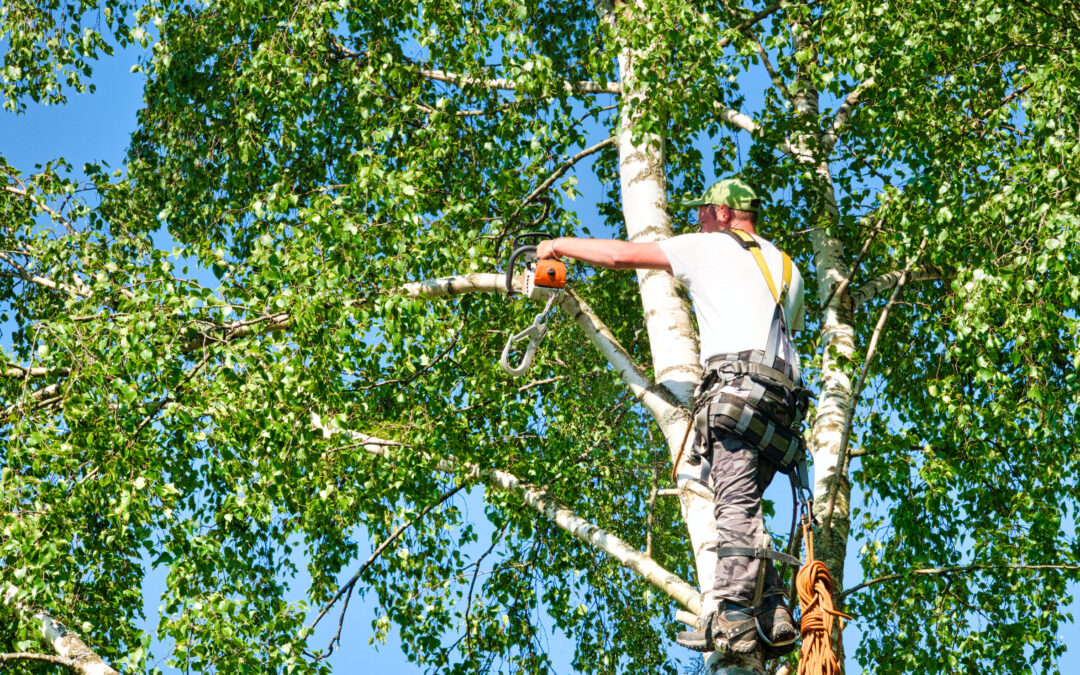Did you know that different things can harm trees? Some of these things may surprise you — but all of them can have a significant impact on the health and well-being of your trees. In this blog post, we’ll explore some of the most common tree hazards and what you can do to protect your trees from them.
1. Mowing the lawn too close to the tree trunk
While mowing the lawn can be an exciting part of maintaining a beautiful yard, many people are unaware of the potentially negative effects that come with cutting too close to tree trunks.
Not only does it strip away a vital layer of bark and leave the trunk vulnerable to environmental stress and pests, but it also leaves the tree exposed to diseases.
These issues can reduce not just its lifespan — but its beauty, as well. It’s important to educate yourself on safe mowing practices around trees, as this can be the difference between a healthy, vibrant landscape and one rife with hazards.
2. Not watering your trees during a drought
Trees need water just like any other living thing, but during periods of drought, extra care must be taken to ensure that your trees are getting the sustenance they need to survive.
When a drought hits, it is essential to deeply and regularly water your trees in order to supplement their nutrient needs and allow them to stay healthy. Without water during protracted droughts, trees can become weakened or die from dehydration or lack of nutrients from the soil or air.
Taking steps to ensure your trees get the water they need during a drought is essential for mitigating these risks and keeping your garden lush and beautiful.
3. Applying too much fertilizer
Applying too much fertilizer can spell disaster for trees — more isn’t always better. Excess fertilizer can lead to nutrient burn, which will damage roots, leaves, and branches.
It can also pollute nearby groundwater sources, so it is important to use only as much as recommended on the packaging. Fertilizers are necessary for proper tree health, but it is important to be mindful and apply them in moderation.
Taking a little time to learn about the particular needs of trees that receive applied fertilizer will mean healthier trees in the long run and help protect ecosystems around us.
4. Planting the tree too deeply
Planting a tree too deeply can cause significant damage, as the roots may not be able to stretch out and take in the oxygen and water they need to grow. If a tree is planted too deep, it may be unable to sustain itself and won’t be as healthy as one that’s been planted at the right depth.
It is essential to know how deep you should be planting your tree when taking into consideration things like soil composition and drainage levels; failure to do so could mean irreparable damage down the line.
5. Not pruning properly
Not pruning trees properly can cause them serious harm, from unbalanced growth to diseases and pest infestations. Proper pruning helps maintain the aesthetic appeal of a tree and promotes healthy new growth for future seasons.
Trees need regular pruning to keep them in their best shape, preserve their lifespan, and ensure they remain healthy and beautiful for years to come.
Professional arborists can assess what kind of pruning a tree may need, ensuring that the work is completed safely and efficiently, while also providing essential preventative care that will protect the tree’s health long-term.
6. Using the wrong type of mulch
Mulch is often seen as a necessary ingredient for soil health. However, it can also be detrimental if used in excess or of the wrong type. Too much or a deep layer of mulch can cause tree problems when moisture gets trapped around the root zone.
This can lead to disturbances in air exchange. Additionally, using materials such as fresh wood chips can lead to fungi growth since they decompose quickly and attract fungus spores. Knowing the right type and amount of mulch is essential to ensure your trees remain healthy.
7. Failing to remove deadwood
It is vital to regularly inspect your trees for deadwood, as this can be a potential hazard and cause significant damage if left unchecked. Deadwood refers to any decaying parts of the tree — such as branches, stems, or leaves — that are no longer alive.
Leaving these on the tree can open it up to pests and diseases, as well as increase the risk of injury during storms. Removing deadwood is essential to maintain tree health and prevent any dangerous or costly damage.
8. Using herbicides near trees
The use of herbicides can be necessary for agricultural and landscaping contexts, but it is important to think carefully about the areas where these are being used.
Applying herbicides too close to trees can cause them serious damage, as many of these substances are toxic to trees and other nearby plants. It is crucial to take extra care when using any kind of chemical product near trees to prevent contamination of soil and water sources and keep your trees healthy.
All in all, trees can be harmed in many ways we wouldn’t typically consider. With a little extra knowledge and effort, however, you can help ensure their health and wellness.
About Marshall Tree Service and Landscaping
Let experts at Marshall’s Tree Services and Landscaping take care of your trees and convert your home into a beautiful work of art. We provide pruning, installation, landscaping, pest control, and tree removal services in the Plantation, East Fort Lauderdale, and Davie regions. To schedule a free review or learn more about our tree trimming and landscaping services, call us at (754) 235-1926 or (786) 738-4886. You can also reach us at melchionnoj@yahoo.com or fill out our contact form to hear back from us.


Recent Comments